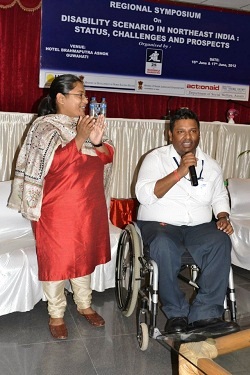Once, during my tenure as Sub Divisional Officer at Biswanath Chariali, Sonitpur district, an IAS probationer came to my office for an ‘exposure’ visit. As we talked, I was surprised to find that the young officer originally from Karnataka spoke reasonably good Assamese for someone who had been in Assam for just a few months. When I mentioned this to him, he beamed with pride and said, “I am learning everything lahe lahe”. “You are already an Assamese if you are doing things lahe lahe,”I said in jest.
Lahe lahe which is similar to the Hindi term dheere dheere is used to describe the easy going, laid back nature of the Assamese. The term is also used pejoratively to describe the Assamese as a slow and lazy people besides giving Assam that unique tag- land of lahe lahe. Though it is actually a cultural stereotype- an over- the- top identity of the Assamese- yet the lahe lahe label also helps in a better understanding of the Assamese character.
It is often said that the lahe lahe nature of the Assamese people is an effect of the wet humid climate of Assam which induces a soporific tendency amongst people making them take their tasks --and life itself-- in a slow, unhurried and laidback manner.
An Assamese farmer tills his land for just one crop in a year. The richness of the soil and the abundantly available water invariably ensures a good crop. It is enough to feed him for the whole year. There is a social taboo about going for another crop in the same year. Every Assamese has a small kitchen garden around his house that gives him his regular supply of greens and the village pond nearby makes available a few fishes every day. What more does he need? From such existential circumstances emerged that lahe lahe nature of the Assamese character.
Another school of thought suggests that the roots of the lahe lahe nature could be traced to the habit of opium orkani consumption amongst the Assamese. In fact, kaniya the Assamese word for a person addicted to opium also means a lazy person. Towards the end of the Ahom reign during the 19 th century, opium consumption amongst the Assamese became rampant. What had been a luxury available only to the elite section of society gradually spread amongst the common people.
Kaniyar Kirtan a satirical play in Assamese written in 1861 by Hem Chandra Barua, one of the fathers of modern Assamese literature, was based on the theme of growing opium addiction amongst the Assamese.
The British Government prohibited the cultivation of poppy from which opium was extracted throughout the province of Assam in April 1860. But at the same time, it did not stop the sale of abkari opium imported from Bihar through Government permits at select outlets all over Assam. At one stroke, the lucrative opium trade became the monopoly of the Government. The Assamese nationalists and intellectuals saw in this dual policy a clever ploy by the British to earn revenue and at the same time subjugate the Assamese by dulling their fighting spirit through opium.
I still remember hearing a fiery speech by Nibarun Bora, one of the stalwarts of the Assam Agitation against illegal migrants, citing the exact amount of kani imported by the British to transform the Assamese into a slow and lethargic people
However, opium could not be blamed only for giving us the lahe lahe nature. During my tenure at Margherita, I saw its use as a medicine amongst the Singhpho and Tangsha tribes of the region. People of these communities still depend on opium for treatment of common ailments. Most households often keep strips of cloth soaked and dried with opium handy for future use. Significantly, peasants in that region are known to take a joint of opium before going out to their fields in the morning for a kick of extra energy.
Blame it on the climate, soil or opium; the lahe lahe nature became ingrained as a way of life of the Assamese. Towards the end of the 19th century, after the coming of the Railways, people from other parts of the country specially from the districts of the then East Bengal migrated in large numbers to Assam.
Despite the Assamese having so many shortcomings, specially that big brotherly attitude towards other communities of the North East, it was again the Assamese who welcomed, with open arms, people from all over India to settle here. Gradually, Assam became one of the most genuinely multi cultural societies in the country. Where else in India would one find a Telegu village situated alongside a Bhojpuri village at one end and a Sema Naga village at the other but in Assam?
Amongst the few possessions that the newly arrived migrants had brought with them in their rucksacks were their ethics of hard work and enterprise. They found Assam a magical land of opportunity and the Assamese, an easy going and emotional lot who at the best of times could be won over by just an offering of tamul pan.
The migrants first settled in the sparsely populated flood plains of the Brahmaputra valley and in the railway towns. Gradually they spread all over Assam. They prospered quickly and in no time the reins of Assam’s economy were in their hands.
Now in their third or fourth generations, the descendents of the early migrants completely integrated and assimilated with Assamese society and became an indistinguishable part of it. Unlike their parents or grandparents, these descendents were born in Assam and nurtured by the climate and soil of Assam. It didn’t take much for some of them to be caught by the spirit of lahe lahe and make them easy going and laidback as the Assamese. The lahe lahe attitude is no longer the sole preserve of the Assamese though we hardly recognize it.
One of my friends, Balbir Singh, a senior engineer in the Power Grid Corporation of India, narrated an incident on how cultural stereotypes actually work. Originally from Amristar, Balbir’s grandfather went to Iraq to seek his fortune in the early part of the 20th century. At Basra, Iraq, someone told him about a prosperous place in North Eastern India called Assam. The adventurous Sikh became attracted enough to come directly to Assam from Basra in1921. He permanently settled in Lanka town, Nagaon district. Now in their third generation in Assam, Balbir and his brothers, went to local schools and had completed assimilated with Assamese society. Balbir studied Civil Engineering in Assam Engineering College, Guwahati. One afternoon, after the completion of his final year’s exams, Balbir was on his way to the railway station in a rickshaw. He was going home to Lanka by train and carried his luggage and some iron and aluminum equipments with him. At Panbazar, the rickshaw was stopped by a group of his classmates seating on the steps of Shaikh Brothers’ Bakery, the usual haunt of final year students of Assam Engineering College during those days. Balbir got down and greeted his class mates. Naimur Rahman, one of his friends noticed the iron and aluminum contraptions on the rickshaw and enquired about them.
Balbir told him that as soon as he return home, his father and he would start a small manufacturing unit at Lanka and the equipments on the rickshaw were for the unit. Naimur congratulated Balbir and gave a small speech extolling how hard working and industrious the Punjabis were. “Look at us, lazy Assamese .All we do is waste our time gossiping on the steps of Panbazar while our class mate here is setting up an industry. No wonder the Punjabis are ahead of us in everything”, he pontificated.
Balbir thanked Naimur for his compliments and left his friends. He could barely conceal his laughter as he had lied before them. The iron and aluminum contraptions that he carried were actually the antenna of a television set he was taking home.
Now, as the world changed dramatically in recent times, the winds of change have swept over Assam too bringing changes in the lives of her people and their attitudes. Roads and transport facilities have improved significantly. A network of paved roads links the remotest areas with the highways.
What was unthinkable even in our fantasies just a few years back is today a reality. How things have changed today. Right before our eyes, we have witnessed the evolution of a world where the real and the virtual coalesced. Today, the infinite possibility of reaching out and making connections with anyone is limited only by our imagination and our inclination.
The somnolent Assamese villages have finally woken up. The image of a man with a plough on his shoulder, trudging along a narrow mud trail, amidst gently swaying paddy stalks now holds a mobile phone on his free hand. Distances have shrunk, blurring the boundaries of villages and cities.
One wonders about the lahe lahe attitude of the Assamese in today’s brave new world. Has it also been discarded like so many other things?
No longer could all Assamese be dubbed slow, easygoing and laidback. The pressures of adjusting to the new circumstances have made some of them as hard working as the Punjabis or as persistent as the Bengalis.
A new generation of Assamese has emerged which scoffs at the slow and laidback attitude of the earlier generations. Even in the villages, the virtues of hard work have caught on amongst the Assamese.
My long tenure of almost six years as a Circle officer in Bhuragaon, Morigaon District, an area inhabited by the benefactors of the controversial Government programme in the thirties of the last century to boost agricultural output by encouraging people from East Bengal to settle in Assam, enlightened me. I saw that the Assamese villages adjoining the villages of the migrants had adopted the agricultural practices of the latter. One such Assamese village that I frequently visited was a village called Gerua. At this village, I saw that more than eighty percent of the households going for jute cultivation that had once been the monopoly of the sturdy migrants. The fields were rarely left fallow.
The tradition of an Assamese villager not to stray too far from his home while seeking employment has also been discarded quietly.
A few years ago, I went to an Assamese village called Barani Pathar under Gohpur Subdivision for verification of a Government scheme. I was surprised to find that there were very few able bodied men working in the scheme. Most of the youths were in far away Bangalore, employed in the factories and offices there. I asked one of the guardians of a youth employed in Bangalore whether getting a job there was difficult. His reply was pleasantly surprising, “It wasn’t difficult as the companies prefer our youths for their hardworking nature.”
True, the Assamese have learnt to adapt with the fast moving times yet there is something embedded in their psyche that make them yearn for a life that is slow, unhurried and simple. The lahe lahe attitude is no longer worn by the Assamese but like a family heirloom, it is still preserved in the consciousness of the Assamese.
Deep within, the Assamese are like the Brahmaputra, gently and unhurriedly flowing through the plains of Assam. Like the Brahmaputra, only occasionally do they rage and fume. Their character is in sync with the character of the great river on whose banks have flourished the culture and civilization of the Assamese people through the ages.
Despite living life on the fast lane, there are some occasions when an Assamese just drops his guard and becomes his true self again. Come spring and when the orchids bloom and the air is filled with the sounds of the pepa and the beat of the dhol, an Assamese just shrugs off everything else and revel in the spirit of Rangali Bihu. Once again he celebrates life lahe lahe.
Find us on facebook: facebook.com/TheThumbPrintMag







































